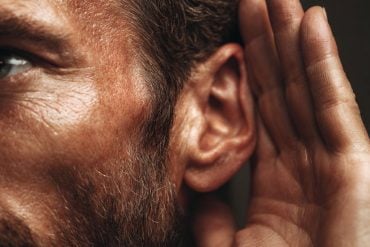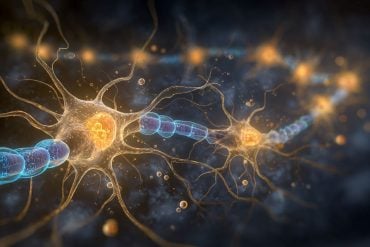Summary: University of Bern researchers report that reproductive hormones don’t only regulate fertility, they also are related to how attractive a woman smells to the opposite sex.
Source: University of Bern.
Reproductive hormones control a woman’s monthly cycle and regulate fertility. Reproductive hormones are also related to how attractive a woman smells a study now shows. Researchers at the University of Bern demonstrate that some women smell better to men than others. Namely those who are “fittest” for reproduction.
We don’t just trust our eyes but we also follow our nose: it’s not just the visual impression that plays an important part when choosing a partner but also their scent – both in the animal kingdom and in human beings. Previous studies have shown that how attractive a woman smells changes across the menstrual cycle: a woman smells most attractive to the male nose during the most fertile days, during the time when she can actually reproduce. What had remained unanswered until now: Do certain women smell “better” than others?
A team of researchers led by Daria Knoch from the Social Psychology and Social Neuroscience Department at the University of Bern working together with colleagues from the University of Constance, the Thurgauer Institute of Economics and University Hospital, Inselspital Bern have now been able to show that this is actually the case: the scent of certain women is universally more appealing to men than others.
Reproductive hormones make a woman’s scent attractive
The team of researchers has also discovered the reason for this: Women are perceived to be more or in fact less attractive by men depending on their hormone levels: “Women with high oestrogen and low progesterone levels are most attractive to men in an olfactory sense,” Daria Knoch sums up the results of the study. Which undoubtedly makes sense from an evolutionary perspective: these hormone levels, lots of oestrogen and not much progesterone, indicate high female fertility. According to evolution theory, men look for women with whom they can successfully reproduce.
The researchers also investigated other factors that might influence body odour: the stress hormone cortisol and certain genes that have an impact on the immune system. “Several studies postulate that the choice of a partner is based on the man and women having a different immune system so that children are given the best possible defence against pathogens from birth,” explains the lead author Janek Lobmaier from the Social Psychology and Social Neuroscience Department at the University of Bern. But the results clearly show: these two factors do not have an influence on how attractive the female scent is.
Strict trial protocol
The researchers conducted their study with 28 women and 57 men. The women who donated their body odour, followed “a strict protocol to minimise any factors that could distort the odour,” says Lobmaier. The women were not allowed to use hormonal contraception, were not allowed to share their bed with anyone during the time of odour collection, they washed themselves and their bed clothes using neutral detergents and did not drink any alcohol or eat any spicy foods on these days. During the time of peak fertility they stuck cotton pads in their armpits overnight to “capture” their unique body odour. Their hormone levels were determined using saliva samples. Later, the men sniffed the cotton pads in the laboratory and awarded each smell 0 to 100 points – with the known result.

A woman’s signals
“Reproductive hormones are indicators of a woman’s fertility. And the higher their levels are the more attractive the woman is to men,” says Lobmaier. Oestrogen, for example, also has a positive effect on how visually attractive a woman is, as studies show: high oestrogen levels make a woman’s face and body attractive to men. And their scent too, with women who are not using hormonal contraception in any case. The study did not investigate how the pill affects this: “However, it is presumed that hormonal contraception may distort the body’s own odour,” says Knoch. The study has now been published in the “Proceedings of the Royal Society B” journal.
Source: University of Bern
Publisher: Organized by NeuroscienceNews.com.
Image Source: NeuroscienceNews.com image is in the public domain.
Original Research: Abstract for “The scent of attractiveness: levels of reproductive hormones explain individual differences in women’s body odour” by Janek S. Lobmaier, Urs Fischbacher, Urs Wirthmüller, and Daria Knoch in Proceedings of the Royal Society B. Published September 12 2018.
doi:10.1098/rspb.2018.1520
[cbtabs][cbtab title=”MLA”]University of Bern”The Scent of a Woman.” NeuroscienceNews. NeuroscienceNews, 12 September 2018.
<https://neurosciencenews.com/female-hormone-smell-9856/>.[/cbtab][cbtab title=”APA”]University of Bern(2018, September 12). The Scent of a Woman. NeuroscienceNews. Retrieved September 12, 2018 from https://neurosciencenews.com/female-hormone-smell-9856/[/cbtab][cbtab title=”Chicago”]University of Bern”The Scent of a Woman.” https://neurosciencenews.com/female-hormone-smell-9856/ (accessed September 12, 2018).[/cbtab][/cbtabs]
Abstract
The scent of attractiveness: levels of reproductive hormones explain individual differences in women’s body odour
Individuals are thought to have their own distinctive body odour which reportedly plays an important role in mate choice. In the present study we investigated individual differences in body odours of women and examined whether some women generally smell more attractive than others or whether odour preferences are a matter of individual taste. We then explored whether levels of reproductive hormones explain women’s body odour attractiveness, to test the idea that body odour attractiveness may act as a chemosensory marker of reproductive fitness. Fifty-seven men rated body odours of 28 healthy, naturally cycling women of reproductive age. We collected all odours at peak fertility to control for menstrual cycle effects on body odour attractiveness. Women’s salivary oestradiol, progesterone, testosterone and cortisol levels were assessed at the time of odour collection to test whether hormone levels explain body odour attractiveness. We found that the men highly agreed on how attractive they found women’s body odours. Interestingly, women’s body odour attractiveness was predicted by their oestradiol and progesterone levels: the higher a woman’s levels of oestradiol and the lower her levels of progesterone, the more attractive her body odour was rated. In showing that women’s body odour attractiveness is explained by levels of female reproductive hormones, but not by levels of cortisol or testosterone, we provide evidence that body odour acts as a valid cue to potential fertility.







